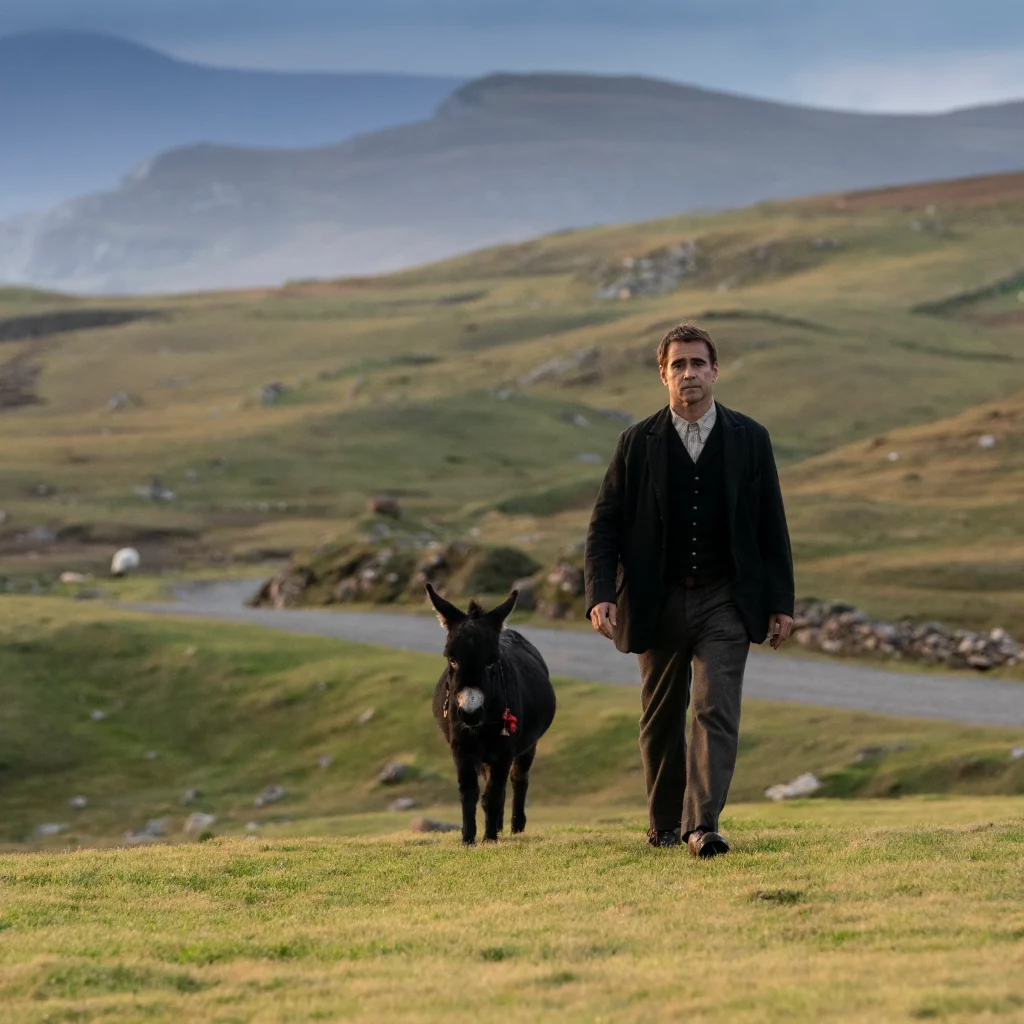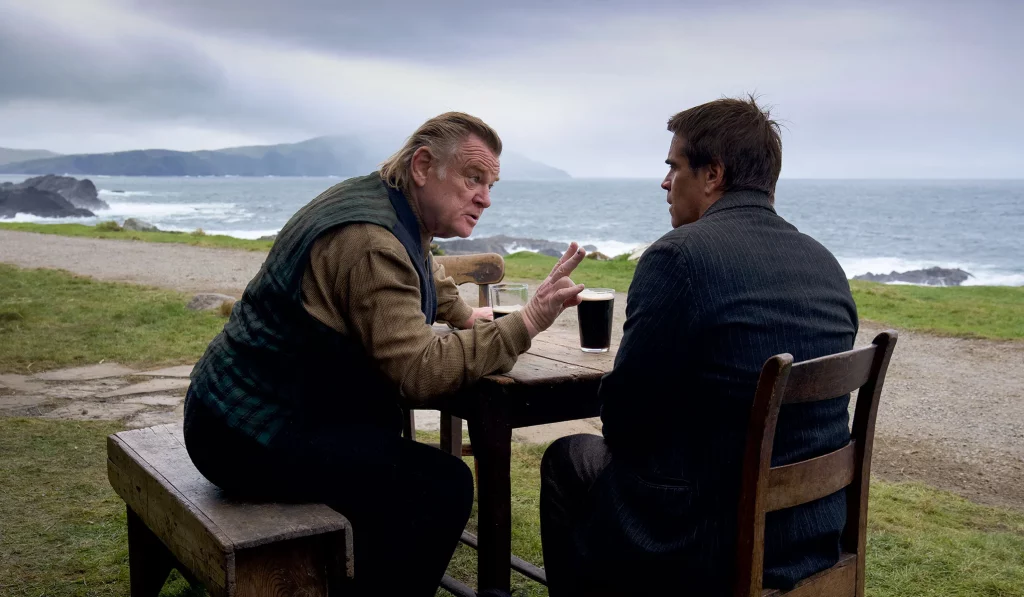
The Banshees of Inisherin (2022) has become a sleeper hit with audiences and a darling with critics. It’s a witty, dark film with some stunning performances. And there is nothing quite like it, at least in recent years. All these aspects allow it to stand out against a loud and brash superhero universe or a saccharine-laced animated bobble-head.
Shot entirely in Ireland, highlighting the stark landscape. It’s rocky and unforgiving, yet stunningly beautiful. It’s quiet. It’s bleak. It’s simple.
And if that’s how you like your movies, you need to watch this one. But if you don’t want to read about symbolism or parallels, you’re going to want to skip the rest of this post.
If you’re worried about spoilers, I won’t give away anything that you can’t glean from the trailer anyhow.
Set in spring of 1923 – precisely a century ago – on a small island of the mainland of Ireland, Banshees is on the surface about two friends having a falling out. Colm Doherty (Brendan Gleeson) has tired of his companion Pádraic Súilleabháin (Colin Farrell) – in English, Patrick Sullivan, if that Gaelic spelling confused you. Pádraic innocently doesn’t understand why his steady and stalwart friend refuses to talk to him any longer. Colm, a fiddle player and folk music composer, feels his life is slipping away with nothing to show for it, and Pádraic is only taking up his remaining time when he could be composing and leaving a legacy.
“I just don’t have a place for dullness in me life anymore,” he says.
Pádraic doesn’t take Colm very seriously, so Colm threatens to cut off one of his fiddle-playing fingers every time Pádraic talks to him. No one in the small village quite believes it – until Colm throws a severed finger at Pádraic’s front door and stalks away. Thus begins the feud on Inisherin.

The setting – time and place – are crucial to the allegory set out in Banshees. In spring of 1923, Ireland was in the midst of a civil war. Occasionally, the sounds of artillery fire can be heard on Inisherin, but the war itself does not affect their daily lives. Having won the right to home rule by fighting the British about five years previously, the young Irish republic faced a number of challenges in creating a new government (A great movie about the politics of this time is Michael Collins). Leaders who were close allies in the fight for independence found themselves against one another when it came to running the country.
In short, some, like Collins, believed Ireland’s best chance to be a successful independent country was to accept the treaty offered by the British, which included the annexation of the six northern counties. In his estimation, continued hostilities against the British was unsustainable and would be foolhardy, leaving all of Ireland in British rule. While not ideal, it would give Ireland a chance to strengthen as a nation and negotiate from a stronger standpoint later.
Others, like Eamon de Valera, were against the treaty as it relinquished Northern Ireland and stipulated commonwealth standing. In his mind, this treaty didn’t go far enough to separate Ireland from its oppressors and didn’t honor the sacrifice of those who fought for independence.
This divide resulted in a year-long war between the two ideologies, each with the same goal: a free and independent Ireland.
Colm and Pádraic’s feud does just mirror a distant battle. It is the essence of this internal conflict. Colm is anti-treaty. He represents old Ireland, tradition over modernity. He values art and creation, and, above all, music. He wishes to leave something that will be talked about for hundreds of years. However many fingers he is forced to lose – or however many counties he is forced to forfeit – he will never capitulate. He will make music regardless.
Pádraic is younger, more mutable. He sees value in kindness and has a measure of hope and innocence still within. He doesn’t understand why multiple attempts to negotiate a peace with Colm fail. He has tried every angle he can think of. When he realizes Colm has only positively reacted to his more visceral outbursts, Pádraic keeps upping the ante. And when Pádraic experiences a loss, however collateral to the feud, he is finally pushed to take drastic action.
Interestingly, when Pádraic is punched by a ne’er-do-well policeman (a stand-in for British occupiers in more ways than one), Colm silently picks him up and helps him home. It’s a reminder that “no one punches my little brother but me.” When pushed from the outside, two sides of the Irish conflict will coalesce against a common enemy. Colm doesn’t hate Pádraic, but he will not budge from his position, even if it results in the loss of his fingers, and his ability to play fiddle.
The women in Banshees are secondary but important characters. Pádraic’s sister Siobhán tries to be a peacemaker between the two at first. She is blunt, smart, and fearless. She will tell anyone what they need to hear, whether they like it or not. The literary one in the small Súilleabháin family, I like to think she represents the influential writer Dorothy MacArdle. MacArdle was an outspoken independent thinker who eventually sided with anti-treaty sentiment. She went on to write one of the seminal works on the fight for an independent Ireland, The Irish Republic (She also wrote three wonderful novels, one of which was adapted into The Uninvited (1944)). MacArdle ultimately sided with Eamon de Valera and the anti-treaty stance though she and de Valera always felt uneasy with the violence against their own countrymen that ensued.
Siobhán is clear headed and thoughtful. Her opinions are strong but they are rooted in studied consideration. And when logic seems to have escaped Colm and Pádraic’s fight, she extricates herself in search of more learned people, or at least people interested in becoming learned.
Then there is the old woman, Mrs. McCormick, who hovers on the edges of everything. She is the oracle, the banshee who warns. She represents the ancient aspects of Ireland, the vaguely supernatural, connection to the natural, and the magical. She appears unexpectedly but precisely as though she has the ability to simply materialize. She dispenses wisdom without making judgment – or at least, she does not share her opinions. She simply points out the obvious, reminds people what is right in front of them.
Mrs. McCormick is also central to the overarching fabulist structure of the story. Ireland’s traditions include rich storytelling and fables, often woven into the deep Catholic presence in the country. A large statue of Mary, painted bright blue and white, is one the few colorful things on the island. It stands at the fork in the road, overseeing all the choices the villagers make – just as the banshee does, draped in her cloak.
The film takes joy in molding the story as a fable, making it feel like a tale from the past as much as it is an allegory for the immediate war on the islanders’ doorstep. Inisherin, translated as Island of Ireland, isn’t a real place, but its misty nonexistence only underscores the fabulism carefully constructed by the movie. Inisherin is real only on the screen, but the complications of friendship, identity, and legacy are enduring.
